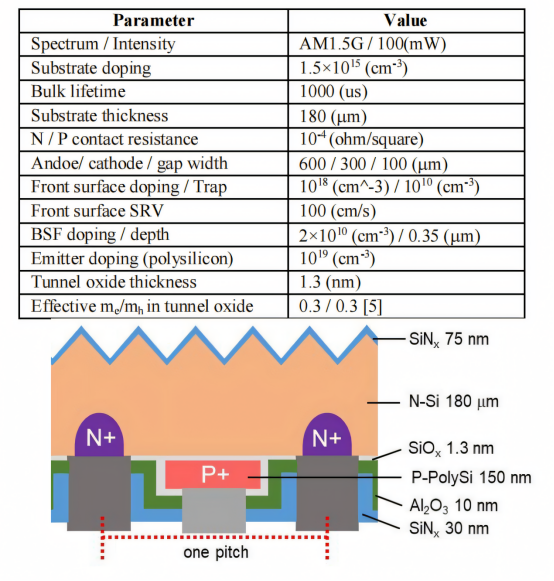
量子效率测试仪
PL/EL一体机
Sinton硅片少子寿命测试仪
Sinton硅块少子寿命测试仪
绒面反射率测试仪
3D共聚焦显微镜
清洗制绒工作站
在线四探针方阻测试仪
全自动扫描四探针方阻测试仪
在线薄膜厚度测试仪
晶化率测试仪
Horiba显微共焦拉曼光谱仪
傅里叶红外光谱仪
霍尔效应测试仪
分光光度计
全光谱椭偏仪
Horiba椭圆偏振光谱仪
TLM接触电阻率测试仪
超景深显微镜
网版智能影像测量仪
全自动影像测量仪
卧式拉力机
电池片稳态光衰老化试验箱
电池片紫外老化试验箱
电池片拉脱力综合测试仪
外观检验台
湿漏电测试系统
组件实验室EL测试仪
紫外老化试验箱
稳态光衰老化试验箱
电流连续性监测系统
PID测试系统
旁路二极管测试系统
LeTID测试系统
反向电流过载系统
脉冲电压测试系统
绝缘耐压测试仪
接地连续性测试仪
绝缘耐压接地测试仪
湿热环境试验箱
湿冻环境试验箱
热循环试验箱
动态机械载荷测试机
静态机械载荷测试机
冰雹冲击试验机
引出端强度试验机
霰弹冲击试验机
抗划伤(切割)测试机
剥离试验机
万能材料试验机(单臂)
万能材料试验机(双臂)
光伏玻璃透过率测试仪
醋酸测试试验箱
交联度测试系统
二极管接线盒综合测试仪
落球冲击试验机
半自动四探针
全自动探针式台阶仪
多通道太阳能MPPT系统
Horiba稳瞬态荧光光谱仪
钙钛矿P1激光划线测试仪
钙钛矿在线膜厚测试仪
钙钛矿工艺检测工作站
手持式IV测试仪
便携式EL测试仪
手持热成像测试仪
户外组件IV测试仪
户外组件多通道测试系统
光伏逆变器电能质量测试仪
无人机EL检测仪
TBC电池结构模拟: 具有混合扩散和TOPCon技术的IBC电池的 TCAD 建模
日期:2024-10-31浏览量:75
IBC硅太阳能电池,如异质结IBC(HJ-IBC)和多晶硅氧化物太阳能电池,已经实现了高效的光电转换效率。这些高效太阳能电池的制造过程复杂且成本高,限制了它们在市场上的应用,结合了混合扩散和TOPCon技术,以降低制造复杂性。TCAD模拟是预测和优化IBC太阳能电池性能的有力工具,而EQE测试则提供了实验验证的手段。通过结合这两种方法,研究人员可以更准确地预测和改进电池性能。
IBC太阳能电池的模型和参数

模拟的IBC太阳能电池的结构
展示了IBC太阳能电池的横截面视图,包括电池的各个层和结构细节。该结构可能包括基底、发射极、隧道氧化物层、多晶硅层、以及前后表面的接触区域。

用于光学生成的随机金字塔(颜色条表示掺杂水平)
这种纹理用于模拟太阳能电池表面的光散射特性,以提高光的捕获率和电池的光电转换效率,这种设计对于提高电池的光吸收和光电转换效率至关重要。通过模拟这些纹理对光吸收的影响,研究人员可以优化电池设计,以实现更高的性能。
模拟的验证方法
光学生成剖面:利用转移矩阵法(TMM)来构建纹理硅中不同深度的光学产生数据。这种方法可以通过计算波长和折射率的关系来确定透射率和反射率。然后,可以通过吸收剂的吸收系数来计算光学产生率。
迁移率模型:掺杂依赖性,迁移率值依赖于掺杂浓度。在半导体中,载流子(电子和空穴)的迁移率会随着掺杂水平的变化而变化,影响电池的电导。
复合模型:采用了经典的SRH复合理论,俄歇复合是我们在基于硅的模型中必须引入的另一种理论,因为它在高浓度区域或高注入条件下会占主导地位。
隧穿模型:该模型侧重于处理隧道氧化层。在这一层中,我们需要引入薛定谔方程来解决隧道问题。
陷阱模型:表面陷阱态,在太阳能电池的前表面添加接受型表面陷阱态。陷阱态可以捕获和释放载流子,影响电池的复合和效率。在模拟中,陷阱密度的选择对电池性能有显著影响。
模拟 J - V 验证

实际与模拟的IV曲线
模拟的J-V曲线与实际J-V曲线完美对应,参数偏差低于1%。这种高度的一致性表明模拟模型能够准确地预测设备的行为,为进一步的优化和设计提供了可靠的基础。
模拟EQE 验证

实际与模拟的EQE曲线
EQE曲线在某些区域,尤其是在红外区域,存在一些偏差。这种偏差可能是由于模拟方法中对AM1.5G光谱的处理方式导致的,模拟中使用了单一波长的光谱来获得光学生成剖面,而实际的AM1.5G光谱是连续的。
EQE曲线通常在400nm到1100nm的波长范围内进行测量,这个范围覆盖了太阳光的主要光谱。在这个范围内,曲线的形状可以揭示电池对不同颜色光的响应能力。
多晶硅优化模拟
通过模拟确定最佳的多晶硅层厚度和掺杂浓度,以最大化太阳能电池的效率。多晶硅层在IBC太阳能电池中通常作为选择性接触,其性能直接影响电池的开路电压(Voc)、短路电流(Jsc)、填充因子(FF)和整体效率。

不同掺杂浓度和厚度的多晶硅层的模拟结果
模拟中考虑了从50nm到300nm的不同多晶硅层厚度;探索了从1e18 cm-3到5e19 cm-3的不同掺杂浓度。
Jsc:Jsc值因多晶硅层的干涉效应而呈现周期性变化。
Voc:高掺杂浓度有利于提高Voc,因为更大的能带弯曲和电导性。
FF:高掺杂浓度也有助于提高FF,因为它们可以减少接触电阻和提高电池的电导性。
效率:效率随着多晶硅层厚度的不同而有小幅度的周期性变化。
背接触比优化模拟
通过模拟确定最佳的阳极和阴极宽度比,以最大化太阳能电池的效率。背接触比率直接影响电池的电流收集和整体性能。

不同比例的阳极和阴极在不同多晶硅掺杂浓度下的模拟效率
阳极/阴极比率:模拟中考虑了不同的阳极和阴极宽度比。
总间距:模拟中假设总间距为1100微米,阳极宽度从100微米变化到800微米,阴极宽度相应减少。

不同阳极宽度和固定间隙宽度条件下的模拟结果
Jsc:随着阳极宽度的增加,Jsc增加,因为更多的少数载流子被阳极收集。
Voc:Voc有轻微的下降趋势,尽管这并不显著影响整体效率。
FF:在某些情况下,当阳极宽度非常大时,FF会突然下降,这表明阴极宽度过小会导致电池性能下降。
激光接触开口偏差模拟
评估激光切割接触孔时的偏差对IBC太阳能电池性能的影响。确定可接受的偏差范围,以保持电池性能在可接受的效率损失范围内。

模拟激光触点开启偏差的效率
效率下降:当激光接触开口出现微小的偏差时,电池效率会迅速下降。特别是偏差超过5微米后,效率下降速率逐渐减缓,直至阴极和掺杂区域完全错位。
可接受的偏差范围:如果激光开口偏差能控制在100纳米以下,效率下降将低于0.5%。
高效TBC太阳能电池的制备
选择P/N比为2:1和100um的间隙进行电池制备,并应用TOPCon技术,制备出的TBC电池效率为20.3%

TBC 太阳能电池的电特性
实际制造的TBC太阳能电池的电学特性,包括开路电压(Voc)、短路电流(Jsc)、填充因子(FF)和光电转换效率(η),提供的数据可以作为质量控制的标准,确保后续生产的电池达到或超过这些性能指标。
通过TCAD模拟优化IBC太阳能电池设计对于提高EQE检测设备性能的重要性,同时也指出了制造过程中精度控制对于确保QE检测准确性的关键作用。
联系电话:400 008 6690
美能QE量子效率测试仪可以兼容测量所有太阳能电池的光谱响应,光谱范围从300nm-2500nm,可以测量EQE、IQE、反射率、透射率和短路电流密度等参数,搭配直径150mm积分球,为让您的光伏研究进展更加顺利。
n 兼容所有太阳能电池类型,满足多种测试需求
n 光谱范围可达300-2500nm,并提供特殊化定制
n 氙灯+卤素灯双光源结构,保证光源稳定性
通过与量子效率测试仪的实验数据对比,验证了TCAD模拟在预测IBC太阳能电池外部量子效率(EQE)方面的准确性。美能QE量子效率测试仪在验证TCAD模拟结果、优化太阳能电池设计、提高制造质量控制效率以及推动测试技术发展方面发挥了重要作用。
原文出处:TCAD Modeling of Interdigitated Back Contact Solar Cells with Hybrid Diffusion and Tunnel Oxide Passivated Contacts




































































